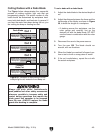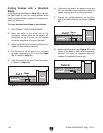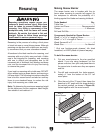
Model G0690/G0691 (Mfg. 11/10+)
-51-
5"
5"
4" Slot
(Top View)
(Side View)
3
/
8
"
Countersink on Bottom
1
/
4
" Hole
Figure 74. Miter bar pattern.
5. Cut a miter bar that will fit in the table miter
slot approximately 5" long, as shown in
Figure 74.
Tip: Consider making the miter bar longer for
larger featherboards—approximately half the
length of the total featherboard—to support
the force applied to the featherboard during
use.
7. Mark a 4" line through the center of the coun-
tersunk hole in the center, then use a jig saw
with a narrow blade to cut it out.
8. Assemble the miter bar and featherboard
with a
1
⁄4"-20 x flat head screw, flat washer,
and a wing nut or a star knob (see Figure
75). Congratulations! Your featherboard is
complete.
4. Rout a
1
⁄4"–
3
⁄8" wide slot 4"–5" long in the
workpiece and 1"–2" from the short end of the
featherboard (see Figure 73).
Figure 73. Slot routed in featherboard.
1"-2"
4"-5"
1
/
4
"-
3
/
8
" Slot
(Side View)
Wing Nut
Miter Bar
Featherboard
Flat Head Screw
Flat Washer
Figure 75. Assembling miter slot featherboard
components.
Note: The routed slot, countersink hole, and
the flat head screw are essential for the miter
bar to clamp into the miter slot. When the
wing nut is tightened, it will draw the flat head
screw upward into the countersunk hole. This
will spread the sides of the miter bar and
force them into the walls of the miter slot,
locking the featherboard in place.
Tip: The length of the flat head screw depends
on the thickness of the featherboard—though
1
1
⁄2" to 2" lengths usually work.
Now, proceed to Mounting Featherboard in
Miter Slot on Page 52.
6. Drill a
1
⁄4" hole in the center of the bar, then
countersink the bottom to fit a
1
⁄4"-20 flat head
screw.


















